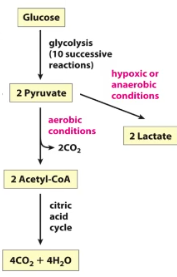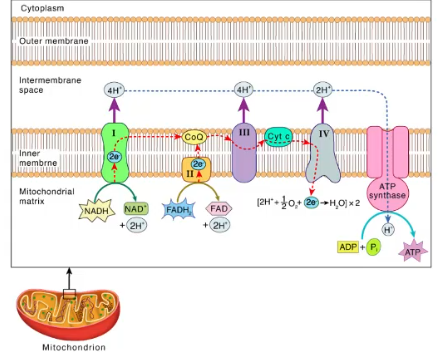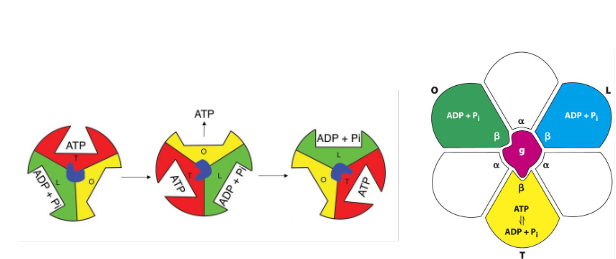The citric acid cycle and oxidative phosphorylation
1/16
There's no tags or description
Looks like no tags are added yet.
Name | Mastery | Learn | Test | Matching | Spaced |
|---|
No study sessions yet.
17 Terms

cellular respiration: The stages and Location
Glycolysis (changes from glucose to pyruvate and occurs in the cytoplasm
Oxidative decarboxylation of pyruvate —> Acetyl CoA occurs in the mitochrondria
Citric acid cycle occurs in the mitochrondria
Oxidative phosphorylation occurs in the mitochrondria

Before the citric acid cycle: fates of pyruvate
Pyruvate is formed by glycolysis
Anaerobic (hypoxic) conditions (with no oxygen):Pyruvate—> lactate
Aerobic conditions (with oxygen): pyruvate—> acetyl CoA—> citric acid cycle
Pyruvate transport: cytoplasm to mitochrondria
Pyruvate is formed in the cytoplasm
Pyruvate—> acetyl CoA: In the mitochrondria
Pyruvate transported: cytoplasm—>mitochrondria
Porin is a prtein which form channels in mitochrondria outer membrane
What is the overall equation of the citric acid cycle?
Acetyl CoA + 3 NAD⁺ + FAD + ADP + Pᵢ + 2 H₂O → CoA + 2 CO₂ + 3 NADH + FADH₂ + ATP + 2 H⁺.
Use the mnemonic to list the steps of the citric acid cycle.
"Can I Keep Selling Seashells For Money, Officer?"
Citrate
Isocitrate
α-Ketoglutarate
Succinyl-CoA
Succinate
Fumarate
Malate
Oxaloacetate
Match the enzyme to its step in the citric acid cycle.
Citrate synthase (Step 1: Acetyl CoA → Citrate).
Aconitase (Step 2: Citrate → Isocitrate).
Isocitrate dehydrogenase (Step 3: Isocitrate → α-Ketoglutarate).
α-Ketoglutarate dehydrogenase complex (Step 4: α-Ketoglutarate → Succinyl-CoA).
Succinyl CoA synthetase (Step 5: Succinyl-CoA → Succinate).
What is oxidative phosphorylation?
The process of ATP formation by transferring electrons from NADH/FADH₂ to O₂ via the electron transport chain (ETC) and chemiosmosis.
List the four complexes of the ETC and their roles
Complex I (NADH dehydrogenase): Transfers electrons from NADH to ubiquinone.
Complex II (Succinate dehydrogenase): Transfers electrons from FADH₂ to ubiquinone.
Complex III (Cytochrome bc₁): Transfers electrons from ubiquinone to cytochrome c.
Complex IV (Cytochrome oxidase): Transfers electrons from cytochrome c to O₂ (forms H₂O).
How does the proton-motive force drive ATP synthesis?
Protons pumped out by ETC create a gradient (high H⁺ in intermembrane space).
Protons flow back through ATP synthase (F₀ subunit), causing rotation.
Rotation induces conformational changes in F₁ subunit (β subunits), synthesizing ATP from ADP + Pᵢ.
What are anaplerotic reactions?
Reactions that replenish citric acid cycle intermediates (e.g., oxaloacetate) when they are used for biosynthesis (e.g., amino acid synthesis).
Why is the citric acid cycle amphibolic?
It serves both catabolic (oxidation of acetyl CoA to CO₂) and anabolic (providing precursors for biosynthesis, e.g., amino acids) roles.
Oxidative phosphorylation
The process of ATP formation by the transfer of electrons from NADH and FADH2 to O2 via a series of electron carriers
Chemiosmosis
The reduction of oxygen means when proton is pumped across the inner mitochondrial membrane

Where does oxidative phosphorylation occur
Occurs in the mitochondria
Electron transport chain enzymes are embedded in the mitochondrial inner membrane
The electron transport chain

F1 β Subunits: Binding-Change Mechanism Hypothesis
Subunit β is one structure with 3 conformations during H+ ion transport across the membrane
L (loose) conformation binds ADP and P loosely: catalytically inactive
T (tight) conformation binds ADP and P tightly and synthesizes ATP which cannot release it